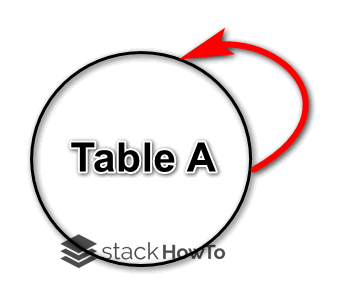MySQL SELF JOIN
In SQL, SELF JOIN is a join of a table with itself. This type of query is not so common but very practical in the case where a table links information with records of the same table.

Syntax :
To perform a SELF JOIN, the syntax of the SQL query is as follows:
SELECT `t1`.`column_name1`, `t1`.`column_name2`, `t2`.`column_name1`, `t2`.`column_name2` FROM `table` as `t1` LEFT OUTER JOIN `table` as `t2` ON `t2`.`fk_id` = `t1`.`id`
Here the join is performed with a LEFT JOIN, but it is also possible to perform it with other types of joins.
Example :
A possible example could be a corporate intranet application that has a table of employees with the hierarchy between them. The employees can be managed by a direct superior who is himself in the table.
Employee table:
+--------+-----------+------+-------------------------------+------------+ | UserID | Name | Age | Address | manager_id | +--------+-----------+------+-------------------------------+------------+ | 1 | Alex | 25 | 819 Saint Francis Way | NULL | | 2 | Emily | 15 | 171 Jarvisville Road Michigan | NULL | | 3 | Jean | 35 | 188 Clay Street Indiana | 1 | | 4 | Bob | 40 | 285 Java Lane Missouri | 2 | +--------+-----------+------+-------------------------------+------------+
The above table shows some employees. The first employees do not have a superior, while employees n°3 and n°4 have respectively employee n°1 and employee n°2 as their superior.
It is possible to list on the same line the employees with their direct superiors, using a query like this one:
SELECT e1.UserID, e1.Name, e2.UserID, e2.Name FROM `Employee` as `e1` LEFT OUTER JOIN Employee as `e2` ON e2.manager_id = e1.UserID
Output:
+-----------+-----------+-----------+-----------+ | e1.UserID | e1.Name | e2.UserID | e2.Name | +-----------+-----------+-----------+-----------+ | 1 | Alex | NULL | NULL | | 2 | Emily | NULL | NULL | | 3 | Jean | 1 | Alex | | 4 | Bob | 2 | Emily | +-----------+-----------+-----------+-----------+





